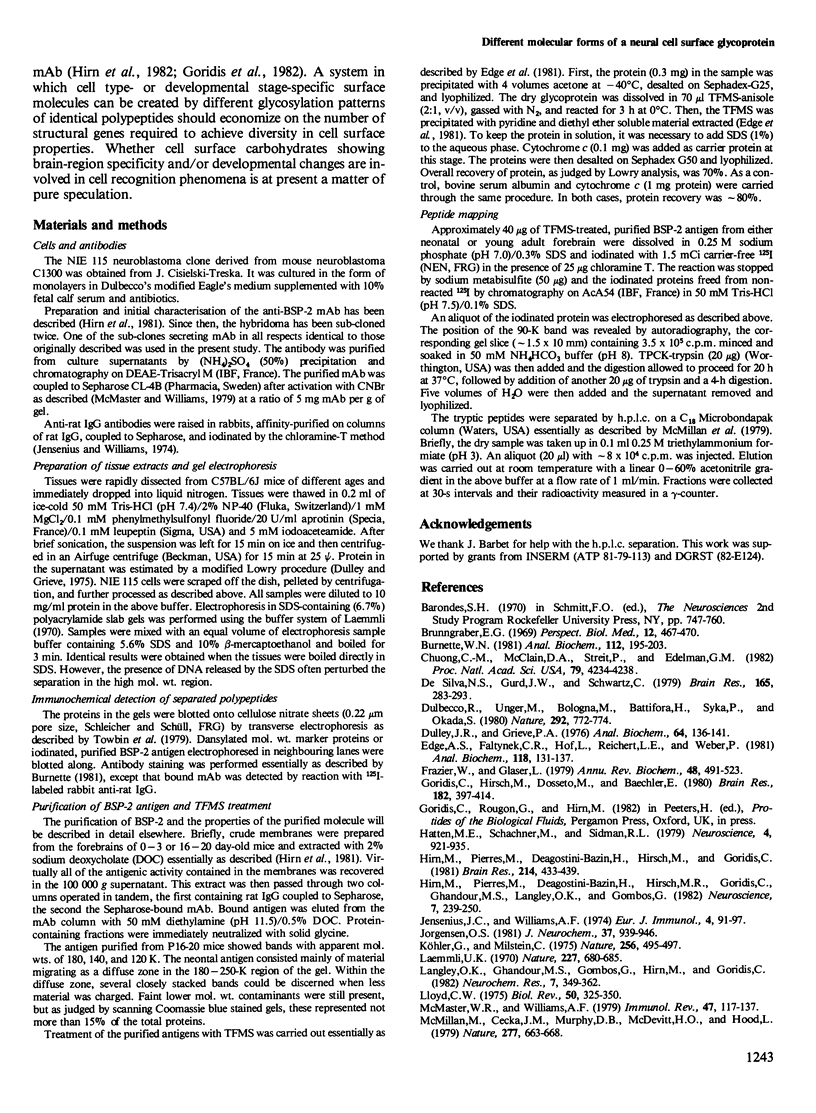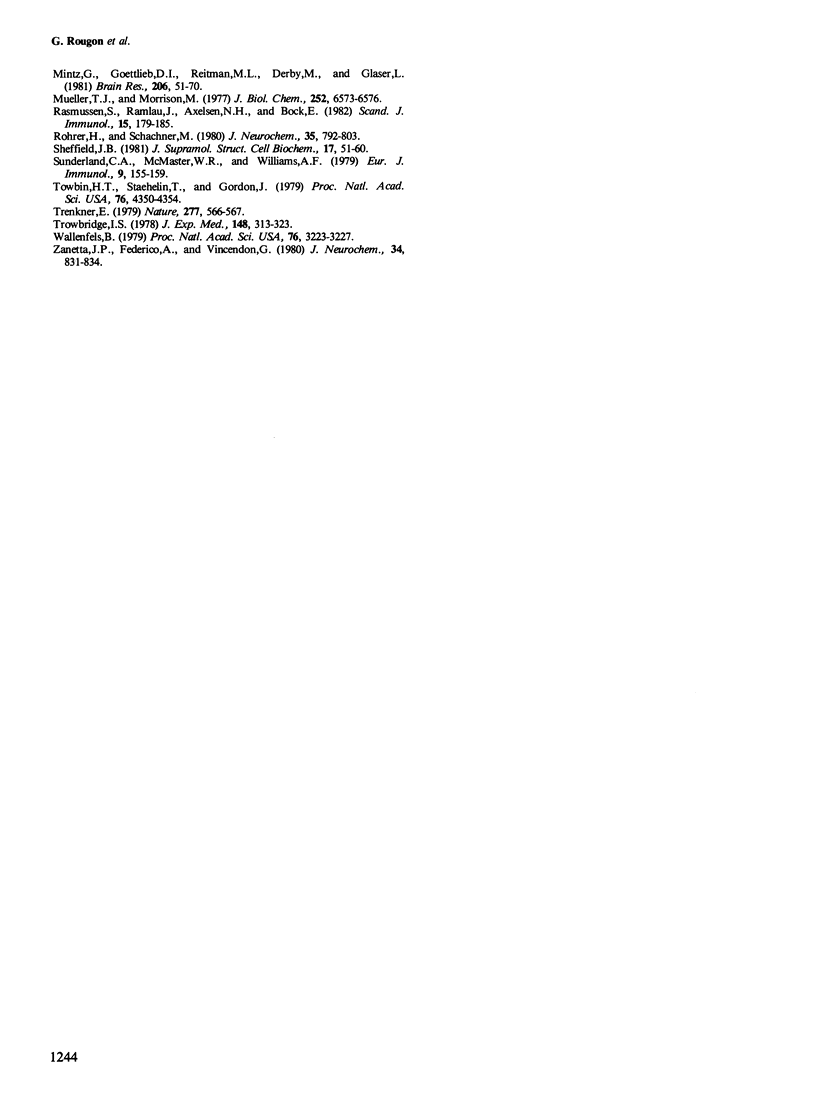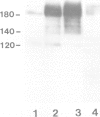Abstract
We have previously identified a cell surface glycoprotein of the mouse nervous system named brain cell surface protein-2 (BSP-2). Here we report that this antigen is not a single, discrete entity, but a family of antigenically and structurally related molecules. Three components of 180, 140, and 120 K were characteristic for more mature nervous tissues. Adult cerebral cortex contained the 140-K and 120-K antigens, adult spinal cord only the 120-K, and dorsal root ganglia from young mice mainly the 180-K component. Very different forms of the antigen that migrated as a diffuse zone from 180-250-K in SDS-polyacrylamide gels were found in immature nervous tissues. A molecule different from the previous ones was found in a neuroblastoma line. Evidence is presented that the structural diversity of BSP-2 is due to differences in glycosylation. This result indicates that cell type- and developmental stage-specific glycoprotein patterns previously found in the nervous system may in part be due to different glycosylation of identical polypeptides. The finding that a neural cell surface protein may be glycosylated in different ways has important implications for the generation of cell surface specificity.
Full text
PDF





Images in this article
Selected References
These references are in PubMed. This may not be the complete list of references from this article.
- Brunngraber E. G. The possible role of glycoproteins in neural function. Perspect Biol Med. 1969 Spring;12(3):467–470. doi: 10.1353/pbm.1969.0012. [DOI] [PubMed] [Google Scholar]
- Burnette W. N. "Western blotting": electrophoretic transfer of proteins from sodium dodecyl sulfate--polyacrylamide gels to unmodified nitrocellulose and radiographic detection with antibody and radioiodinated protein A. Anal Biochem. 1981 Apr;112(2):195–203. doi: 10.1016/0003-2697(81)90281-5. [DOI] [PubMed] [Google Scholar]
- Chuong C. M., McClain D. A., Streit P., Edelman G. M. Neural cell adhesion molecules in rodent brains isolated by monoclonal antibodies with cross-species reactivity. Proc Natl Acad Sci U S A. 1982 Jul;79(13):4234–4238. doi: 10.1073/pnas.79.13.4234. [DOI] [PMC free article] [PubMed] [Google Scholar]
- De Silva N. S., Gurd J. W., Schwartz C. Developmental alteration of rat brain synaptic membranes. Reaction of glycoproteins with plant lectins. Brain Res. 1979 Apr 13;165(2):283–293. doi: 10.1016/0006-8993(79)90560-2. [DOI] [PubMed] [Google Scholar]
- Dulbecco R., Unger M., Bologna M., Battifora H., Syka P., Okada S. Cross-reactivity between Thy-1 and a component of intermediate filaments demonstrated using a monoclonal antibody. Nature. 1981 Aug 20;292(5825):772–774. doi: 10.1038/292772a0. [DOI] [PubMed] [Google Scholar]
- Dulley J. R., Grieve P. A. A simple technique for eliminating interference by detergents in the Lowry method of protein determination. Anal Biochem. 1975 Mar;64(1):136–141. doi: 10.1016/0003-2697(75)90415-7. [DOI] [PubMed] [Google Scholar]
- Edge A. S., Faltynek C. R., Hof L., Reichert L. E., Jr, Weber P. Deglycosylation of glycoproteins by trifluoromethanesulfonic acid. Anal Biochem. 1981 Nov 15;118(1):131–137. doi: 10.1016/0003-2697(81)90168-8. [DOI] [PubMed] [Google Scholar]
- Frazier W., Glaser L. Surface components and cell recognition. Annu Rev Biochem. 1979;48:491–523. doi: 10.1146/annurev.bi.48.070179.002423. [DOI] [PubMed] [Google Scholar]
- Goridis C., Hirsch M., Dossetto M., Baechler E. Identification and characterisation of two surface glycoproteins on cultured cerebellar cells. Brain Res. 1980 Jan 27;182(2):397–414. doi: 10.1016/0006-8993(80)91197-x. [DOI] [PubMed] [Google Scholar]
- Hatten M. E., Schachner M., Sidman R. L. Histochemical characterization of lectin binding in mouse cerebellum. Neuroscience. 1979;4(7):921–935. doi: 10.1016/0306-4522(79)90176-3. [DOI] [PubMed] [Google Scholar]
- Hirn M., Pierres M., Deagostini-Bazin H., Hirsch M. R., Goridis C., Ghandour M. S., Langley O. K., Gombos G. A new brain cell surface glycoprotein identified by monoclonal antibody. Neuroscience. 1982 Jan;7(1):239–250. doi: 10.1016/0306-4522(82)90164-6. [DOI] [PubMed] [Google Scholar]
- Hirn M., Pierres M., Deagostini-Bazin H., Hirsch M., Goridis C. Monoclonal antibody against cell surface glycoprotein of neurons. Brain Res. 1981 Jun 15;214(2):433–439. doi: 10.1016/0006-8993(81)91208-7. [DOI] [PubMed] [Google Scholar]
- Jensenius J. C., Williams A. F. The binding of anti-immunoglobulin antibodies to rat thymocytes and thoracic duct lymphocytes. Eur J Immunol. 1974 Feb;4(2):91–97. doi: 10.1002/eji.1830040207. [DOI] [PubMed] [Google Scholar]
- Jørgensen O. S. Neuronal membrane D2-protein during rat brain ontogeny. J Neurochem. 1981 Oct;37(4):939–946. doi: 10.1111/j.1471-4159.1981.tb04481.x. [DOI] [PubMed] [Google Scholar]
- Köhler G., Milstein C. Continuous cultures of fused cells secreting antibody of predefined specificity. Nature. 1975 Aug 7;256(5517):495–497. doi: 10.1038/256495a0. [DOI] [PubMed] [Google Scholar]
- Laemmli U. K. Cleavage of structural proteins during the assembly of the head of bacteriophage T4. Nature. 1970 Aug 15;227(5259):680–685. doi: 10.1038/227680a0. [DOI] [PubMed] [Google Scholar]
- Langley O. K., Ghandour M. S., Gombos G., Hirn M., Goridis C. Monoclonal antibodies as neural cell surface markers. Neurochem Res. 1982 Mar;7(3):349–362. doi: 10.1007/BF00965646. [DOI] [PubMed] [Google Scholar]
- Lloyd C. W. Sialic acid and the social behaviour of cells. Biol Rev Camb Philos Soc. 1975 Aug;50(3):325–350. doi: 10.1111/j.1469-185x.1975.tb00832.x. [DOI] [PubMed] [Google Scholar]
- McMaster W. R., Williams A. F. Monoclonal antibodies to Ia antigens from rat thymus: cross reactions with mouse and human and use in purification of rat Ia glycoproteins. Immunol Rev. 1979;47:117–137. doi: 10.1111/j.1600-065x.1979.tb00291.x. [DOI] [PubMed] [Google Scholar]
- McMillan M., Cecka J. M., Hood L., Murphy D. B., McDevitt H. O. Peptide map analyses of murine Ia antigens of the I-E subregion using HPLC. Nature. 1979 Feb 22;277(5698):663–665. doi: 10.1038/277663a0. [DOI] [PubMed] [Google Scholar]
- Mintz G., Gottlieb D. I., Reitman M. L., Derby M., Glaser L. Developmental changes in glycoproteins of the chick nervous system. Brain Res. 1981 Feb 9;206(1):51–70. doi: 10.1016/0006-8993(81)90100-1. [DOI] [PubMed] [Google Scholar]
- Mueller T. J., Morrison M. Detection of a variant of protein 3, the major transmembrane protein of the human erythrocyte. J Biol Chem. 1977 Oct 10;252(19):6573–6576. [PubMed] [Google Scholar]
- Rasmussen S., Ramlau J., Axelsen N. H., Bock E. Purification of the synaptic membrane glycoprotein D2 from rat brain. Scand J Immunol. 1982 Feb;15(2):179–185. doi: 10.1111/j.1365-3083.1982.tb00636.x. [DOI] [PubMed] [Google Scholar]
- Rohrer H., Schachner M. Surface proteins of cultured mouse cerebellar cells. J Neurochem. 1980 Oct;35(4):792–803. doi: 10.1111/j.1471-4159.1980.tb07075.x. [DOI] [PubMed] [Google Scholar]
- Sheffield J. B. Glycoprotein differences among cells of the 14-day embryonic chick neural retina. J Supramol Struct Cell Biochem. 1981;17(1):51–60. doi: 10.1002/jsscb.380170106. [DOI] [PubMed] [Google Scholar]
- Sunderland C. A., McMaster W. R., Williams A. F. Purification with monoclonal antibody of a predominant leukocyte-common antigen and glycoprotein from rat thymocytes. Eur J Immunol. 1979 Feb;9(2):155–159. doi: 10.1002/eji.1830090212. [DOI] [PubMed] [Google Scholar]
- Towbin H., Staehelin T., Gordon J. Electrophoretic transfer of proteins from polyacrylamide gels to nitrocellulose sheets: procedure and some applications. Proc Natl Acad Sci U S A. 1979 Sep;76(9):4350–4354. doi: 10.1073/pnas.76.9.4350. [DOI] [PMC free article] [PubMed] [Google Scholar]
- Trenkner E. Postnatal cerebellar cells of staggerer mutant mice express immature components on their surface. Nature. 1979 Feb 15;277(5697):566–567. doi: 10.1038/277566a0. [DOI] [PubMed] [Google Scholar]
- Trowbridge I. S. Interspecies spleen-myeloma hybrid producing monoclonal antibodies against mouse lymphocyte surface glycoprotein, T200. J Exp Med. 1978 Jul 1;148(1):313–323. doi: 10.1084/jem.148.1.313. [DOI] [PMC free article] [PubMed] [Google Scholar]
- Wallenfels B. Developmental and mutational changes of glycoproteins in the mouse neuronal retina: studies with bovine galactosyltransferase. Proc Natl Acad Sci U S A. 1979 Jul;76(7):3223–3227. doi: 10.1073/pnas.76.7.3223. [DOI] [PMC free article] [PubMed] [Google Scholar]
- Zanetta J. P., Federico A., Vincendon G. Glycosidases and cerebellar ontogenesis in the rat. J Neurochem. 1980 Apr;34(4):831–834. doi: 10.1111/j.1471-4159.1980.tb09654.x. [DOI] [PubMed] [Google Scholar]






